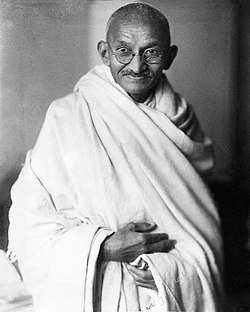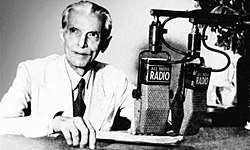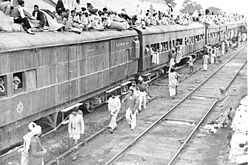The Partition of India took place in the aftermath of the Second World War, Britain finally granted independence to India. This was a region that had been governed as the British Raj for the better part of a century, but independence presented its own problems, as there were distinct parts of the Raj which were dominated by practitioners of Hinduism, while smaller parts of the country, particularly in the north-west and north-east, had a sizeable Muslim majority. Sectarian tensions between Muslims and Hindus seemed inevitable and so a decision was taken to split the Raj into two major countries as independence was granted. These were to be a Hindu-majority India and a Muslim-majority Pakistan. But the dividing lines between Muslims and Hindus were not as clear cut. Thus, population transfers and migration on the basis of religion ensued. This was one of the largest mass migrations in history, with over fourteen million people leaving their homes and moving across borders as a result.[1]
Chronology of eventsChronology of events

British rule in India had actually commenced in the seventeenth and eighteenth centuries through the auspices of the English East India Company. This, by some standards the largest corporation in human history, conquered India on behalf of its shareholders in England, but eventually, it was demonstrated that it could not effectively control such a large territory when a great mutiny broke out across India against company rule in 1857. As a result, the British government took direct control over India as the British Raj following the mutiny. This was a highly complicated colony, one where different languages, cultures, and religions prevailed. In particular, Hinduism was dominant in the south and central regions of the sub-continent, while Islam prevailed to the north-west in what is now Pakistan and the north-east in what is now Bangladesh.[2]
The mutiny of 1857 was a foretaste of the development of the Indian independence movement. By the early twentieth century, campaigners like Mahatma Gandhi were pressuring the British government to grant the country greater levels of self-government with a view to full independence one day. The British government resisted relinquishing control of such a valuable colony, but when the Second World War broke out in 1939, Prime Minister Winston Churchill had little option but to promise independence one day in return for India’s aid during the conflict. The Indian Independence Bill was duly promulgated in August 1947.[3]

Independence created a problem; the Raj was divided into regions where Hindus and Muslims predominated. Both showed little willingness to work in accord with each other, wanting their own state. Thus, when independence was granted, two nations were created: one was India which approximates very closely to the modern state of India. The other was Pakistan, which corresponds approximately with the countries of Pakistan and Bangladesh today; this consisted of two different blocks of land where Muslims predominated. However, it was soon realized that two disparate sections of the country could not be governed together and measures were taken from the mid-1950s to separate West Pakistan and East Pakistan, resulting eventually in 1971 in the creation of Bangladesh out of East Pakistan.[4]
Long before the issue of a divided Pakistan had been resolved, there were concerns about how many Hindus would continue to live in Pakistan and how many Muslims were trapped within the borders of India. Accordingly, the partition of India and the granting of independence in 1947 also brought with it a scheme for population transfers, whereby Muslims would leave India and head to Pakistan and vice-versa. This would result in one of the largest mass migrations in human history.
Extent of migrationExtent of migration

It is estimated that about 14 million people moved between the two new countries in a very short space of time in the second half of the 1940s. Censuses were undertaken in 1951 in both India and Pakistan and these revealed that there were approximately 7.2 million people from India living in Pakistan and an almost identical number from Pakistan living in India. This would suggest a figure of around 14.5 million people that moved between the two countries following partition, though there would have been some natural increase in numbers over the few years since the migration.
The Partition of India did not constitute all of the Muslims in India leaving for Pakistan and vice-versa. Many Muslims remained in India and some Hindus remained in Pakistan. Instead, people tended to have migrated if they knew that they would find themselves in a particular minority in their region. For example, if a town had a small minority of Muslims constituting 5% of the population, these were more likely to head for Pakistan, whereas in towns and cities in Gujarat, for instance, where Muslims were a much larger minority, people tended to stay as they had some considerable strength in numbers and the chances of future persecution under Hindu rule were not as great.[5] Modern studies have also indicated that after the initial period of intense migration in the mid-to-late 1940s, millions of people continued to cross the borders between Pakistan and India throughout the 1950s.[6]
Demographic impactDemographic impact
The demographic impact of the population exchanges which occurred as part of the Partition of India is clear. It created a much more monolithically Muslim state in Pakistan. Out of a population of just over 230 million people there today, just 4.5 million are Hindus. This number would be significantly higher if the migrations attendant on the partition had never occurred, particularly so given natural population increase since the late 1940s. By way of comparison, the migration of Muslims from India to Pakistan has done little to dent the size of the Muslim minority in India. There are over 170 million Muslims living in India today (with some studies placing the number as high as 200 million) accounting for some 14% of the population.[7] As such, the transfer of some 7.2 million Muslims to Pakistan or Bangladesh back in the 1940s has done little to limit the size of the Muslim minority within India. And, unfortunately, incidents such as the Gujarat riots of 2002 when the current Indian Prime Minister, Narendra Modi, was chief minister of Gujarat, have demonstrated how deep religious tensions run over half a century later. During this period of violence upwards of 2,000 Muslims lost their lives in Gujarat and roughly 200,000 people were displaced.[8] As such, while the mass migrations and population transfers which were attendant on the partition of India were enormous, religious tensions in the former lands of the British Raj continue today.
Explore moreExplore more
- Search newspaper collections on MyHeritage
- Search immigration and travel records on MyHeritage
- From India to Dubai: The Saleem family on the MyHeritage Blog
References
- ↑ Partition: Why was British India divided 75 years ago? BBC News
- ↑ The East India Company. British Library
- ↑ This Day in History:India and Pakistan win independence. History Channel
- ↑ Why was British India Partitioned in 1947? Considering the role of Muhammad Ali Jinnah. University of Oxford
- ↑ Faith, fury and fear: The story behind one of history’s greatest mass migrations. CNN
- ↑ Visaria, Pravin M. Migration between India and Pakistan, 1951–61. Demography 6, 323–334 (1969).
- ↑ 1 city, 2 people — and India’s widening religious divide. Associated Press
- ↑ Understanding Gujarat Violence. Social Science Research Council

